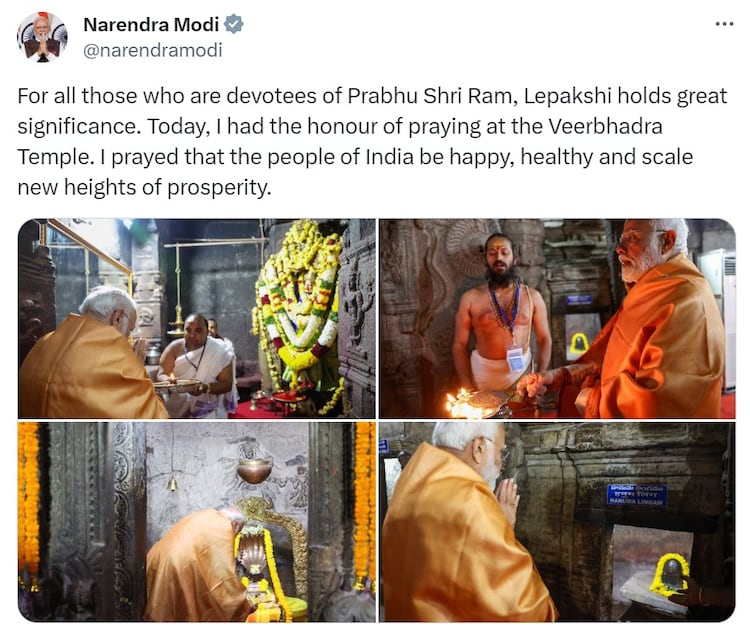Prime Minister Narendra Modi, who is on an 11-day special ritual for the ‘pran pratishtha’ (consecration) of Lord Ram’s idol at the Ayodhya Ram temple, visited another historical site on Tuesday linked to the Ramayana.
Days after visiting the Kalaram Mandir in the Panchavati area of Maharashtra’s Nashik, PM Modi offered prayers at Veerabhadra temple in Lepakshi in Andhra Pradesh.
During his visit, PM Modi chanted Lord Ram ‘bhajans’ (prayer songs) and also heard verses from the ‘Ranganatha Ramayan’, the Telugu rendition of the Hindu epic. The Prime Minister also watched a puppet show on the Ramayana and shared images from his spiritual journey.
“For all those who are devotees of Prabhu Shri Ram, Lepakshi holds great significance. Today, I had the honour of praying at the Veerbhadra Temple. I prayed that the people of India be happy, healthy and scale new heights of prosperity,” PM Modi tweeted.
While the ancient temple located in Sri Satyasai district is known for its architectural grandeur, the shrine holds a special place in the Ramayana.

SIGNIFICANCE OF LEPAKSHI IN RAMAYANA
In Telugu, the name ‘Lepakshi’ means ‘Rise, oh bird’. The town has been named as a tribute to Jatayu, the giant vulture-like mythical bird who fought valiantly with Ravan after he kidnapped Sita and was taking her to Lanka on his Pushpaka Vimana.
As per the Ramayana, it is believed that Lepakshi is the area where Jatayu, grievously wounded by Ravan during their fight, fell.
It is here that Jatayu informs Lord Ram and his brother Laxman that Sita had been kidnapped by Ravan, and they should move southwards towards the seashore to reach Lanka. Jatayu was then granted moksha (liberation from the cycle of death and rebirth) by Lord Ram.
The Lepakshi temple is also believed to have preserved footprints of Goddess Sita.
The temple town has several ancient shrines devoted to Lord Shiva, Vishnu, Raghunath, Ram and contain narratives from Hindu mythology. The intricate architecture inside the temples is believed to be a work of artisans from the Vijayanagara dynasty.
PM MODI IN PANCHAVATI, KALARAM TEMPLE
Last week, on January 12, PM Modi visited the Kalaram temple in the Panchavati area. Both the area and temple have historical significance linked to the Ramayana as a number of important events described in the epic took place here.
It is believed that Lord Ram, Sita and Laxman settled here first during their 14-year exile in the forest of which Panchavati was a part. It is from this forest that Ravan abducted Sita after drawing her out from the hut made by Ram and Laxman.
The Kalaram temple, where PM Modi offered prayers and listened to the verses of ‘Bhavartha Ramayana’ written in Marathi, is believed to have been rebuilt in 1700 after it was destroyed by Mughals.
It is believed that Lord Ram killed 14,000 demons in just 1.5 minutes and, therefore, the temple is called ‘Kalaram’ as he came as ‘kaal’ (death) for demons. The other reason behind the name of the temple is also the colour of Ram’s idol, which is made of black stone.
The temple is made of black basalt stone. The temple has 14 steps, denoting the 14 years of exile of Lord Ram. The idols of Lord Ram, Laxman and Sita are also black. The idol of Lord Ram does not have a bow and arrow, and is in a position in which he is giving blessings.
Tune In
